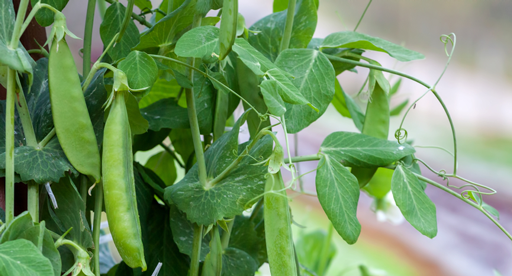
5 Steps to Pea Planting Success
- Choose a spot in full sun away from strong winds.
- Prepare your soil with organic matter like sheep pellets and compost.
- Add a layer of vegetable mix to plant into. Peas are best planted in autumn, late winter or early spring in New Zealand.
- Use stakes, trellis or a tepee to keep the crop off the ground and provide a growing structure.
- Feed your peas over the growing season with vegetable food and water regularly.
Follow our full guide below to a bumper crop of homegrown peas.
Fresh homegrown peas off the plant are hard to beat! Peas are best grown in autumn, late winter and early spring, before the warm weather. Plant plenty of them - the temptation to enjoy a few before they make it to the kitchen can be too much.
Prepare
An added bonus with peas is that because they are a legume, they give your soil a welcome boost at the end of the season. Legumes extract nitrogen from the air and store it in little pimple-like nodules along their roots.
Choose a spot in full sun that is away from strong winds. Use stakes, trellis or a tepee to keep the crop off the ground and to provide a growing structure.
Shop Tui Pea Seeds - Snow and Sugar Snap, reliable favourites for the whole family.
Refer to our Planting Calendar for when to plant peas in your region.
Plant
Like building a house a good foundation is the key to success in your garden. The better the soil, the better your plants will grow. Peas like a rich, moist, cool soil. If you are starting with an existing garden bed dig in organic matter like Tui Sheep Pellets and Tui Compost to your soil. Then you can add a layer of Tui Vegetable Mix. If planting in pots and containers, fill with Tui Vegetable Mix.
Avoid planting peas in the same areas two years in a row if they have had disease the season prior.
The best times to plant are early in the morning or late in the day, so the plants aren’t exposed to the hot sun straight away. Always water plants well before and after planting.
Sow seeds late in winter and plant out once the soil has warmed up.
Planting in garden beds
- Water plants thoroughly before planting and allow to drain.
- Dig a hole, approximately twice the depth and width of the root ball of your plant.
- Partly fill the hole with Tui Vegetable Mix.
- Gently loosen the root ball of your plant and position the plant in the centre of the hole.
- Fill in with Tui Vegetable Mix.
- Press soil gently around the base of the plant.
- Water your plant well.
Planting in pots and containers
Select a pot or container that is at least 40L.
- Water plants thoroughly before potting and allow to drain.
- Partly fill your container with Tui Vegetable Mix.
- Gently loosen the root ball of your plant and position the plant in the container.
- Fill your container with Tui Vegetable Mix up to 3cm from the top.
- Tap the container gently on the ground to settle the mix.
- Press soil gently around the base of the plant.
- Water your plant well.
Nourish
Feed your plants and they will feed you. Plants use nutrients from the soil as they grow, so replenishing the nutrients ensures your plants grow to their full potential. Select a fertiliser specially blended for your crop like Tui Vegetable Food. Feed peas planted in pots and containers with Tui NovaTec Premium fertiliser.
Well-watered, well-nourished peas will have a better chance of keeping insect pests and diseases at bay. Keep the soil moist but not wet and keep an eye out for aphids and whitefly as the weather warms.
While your peas are growing regularly apply a dose of Tui Organic Seaweed Plant Tonic to give them a welcome boost.
Harvesting
Pick pods when they look large and feel full to touch. When peas are finished, you can dig the plants back into the soil to break down and release the nitrogen stored in them.
Be vigilant and stop unwanted insects and diseases from ruining your plants. Slugs and snails can be an issue - lay Tui Quash slug and snail control around young plants.
- Jan
- Feb
- Mar
- Apr
- May
- Jun
- Jul
- Aug
- Sep
- Oct
- Nov
- Dec
- Harvest in 45-70 days